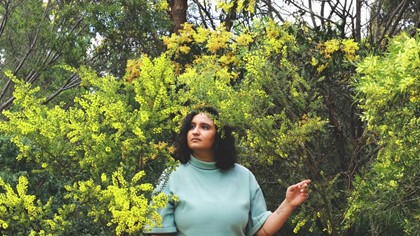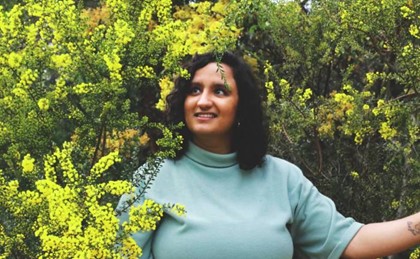Where are the blockages in our industry, and how do we break them down? Audience Outreach Coordinator Aakanksha Sidhu looks to gender and nature for ways to think beyond the binaries.
There is a layer of experience in the performing arts that is intangible. Poets, writers, musicians, theatre markers, and dancers have all attempted to capture this dynamism of performance as a cultural phenomenon. Most have also self-admittedly fallen short of articulating the experience in its entirety. If I were to try to present the plurality of performance, (admittedly hating generalizations) I would simply compare it to nature itself. Performance practice, like nature, is a system of layers that work independently, interdependently, and collaboratively to sustain humanity. Just like our natural world, our performance scene is calling for attention, liberation, and healing for a sustainable and inclusive future. They are also more interlinked than we think.
To clarify, when comparing performance to nature I want to steer far away from ideas of Darwinian biological determinism. Instead, I bring attention to the very queer understanding presented by Joan Roughgarden, in Evolution’s Rainbow (2004):
“Organisms flow across the bounds of any category we construct. In biology, nature abhors a category...[T]he most common body form among plants and in perhaps half of the animal kingdom is for an individual to be both male and female at the same, or at different times during its life.”
Although this quote deals more directly with gender and biology, it forms an ideal beginning to explain who I am and what this blog post is about. I am a creativity and arts professional who’s early career has been a range of education and professional experiences, purposefully threaded with a passion for arts equity and opportunity for all. In solving problems, I look for guidance from those who have had the greatest degrees of oppression and marginalization. Those that have done the work for decades, that have spoken about what needs to change and who have faced the brunt of the constructions of static understandings of cultural production. I orient myself to IBPOC, d/Deaf, disabled and caste-oppressed communities as the agents of colonial binary deconstruction. It is in their creativity and power I find myself empowered to self-examine and relearn my own binaries. My hope for all future producers is that they do the same.
When thinking about the performing arts landscape locally and globally, it has been important for me to understand the plurality of a ‘scene’, ‘industry’ or ‘sector’, however you feel comfortable categorising it. Cultural organisms, whether independent or institutional, are imagined structures. They are boundless, with people, energy and ideas continuously flowing between each other. The problem with boxes like the ‘institutional’ vs. the ‘independent’ is that is does not account for the flow that happens inherently, but needs to be further supported.
Another binary understanding of creativity I have trouble digesting is the segregation between music, theatre, and dance or between the gallery and outdoor place, the architectural and natural place. These distinctions although true, are also porous. The homogenisation and othering that is present in the cultural scene needs urgent disruption and compassionate restructuring. To define something as one thing, and only one thing, is a binary I reject, and hope you will too.
What being non-binary has in common with creativity is the unrelenting desire to chase our internal curiosity.
To question everything present around us and to find answers that often lead to more questions. Bringing an internal awareness and connection to nature into our cultural production will only help the current and next generation of creatives explore the fluidity of the work we need to do for the future sustainability of the sector.
The creatives that I look up to are those who have embraced a non-binary nature of being creative. Producers are my favourite creatives for this reason. They are micro-entrepreneurs who understand the breadth of functions of a creative activity. Creative producers – be they curators, directors, leaders of creative organizations, or independent programmers and artists– require a plural metaphor as large as nature to encapsulate what they do. Like a mature tree, they are deeply rooted underground, with their hands in various layers of the soil. As outsiders and insiders, they know what others see of them is just what has come above ground. The work that happens underneath is what gives the fruit, beautiful shade, and biodiversity to the performance scene around them.
But what is a producer in a non-traditional sense and how has the idea of a producer changed? It needs updating and a rejiggle for definition. Because the idea of creativity has changed, so needs too the idea of the independent artist, the institution, and the producers that expand the branches between these systems.
Producing has become interlinked with other systems of making. They may be a writer, an administrator, sometimes director and a budgeter. They are also a digital designer, part-time therapist, and artist manager. These roles are not limited to a kind of producer, but to most who find their ways into creativity today. Performing arts specifically asks of its participants at all levels to engage with skills beyond what one may assume sits in the box of their role, niche, or area of expertise. Producers, whether of events, plays, music, performances, or live-ness of any kind, demonstrate the very poly-creative manifestation that imaginative artistic activity is. In adapting to take on multiple creative and administrative roles, producers to me demonstrate the very queer, gender-fluid, or in this case interdisciplinary behaviour Roughgarden’s understanding of nature demonstrates.
With this non-binary fluidity comes vulnerability and deep honesty. Although it sounds invigorating, rewarding and a great space for growth, it is also the curse of the crew. Following curiosity, questioning structures, and resisting binary boxes can lead to fatigue and burnout.
We sacrifice our personal boundaries, and often go through career shifts that are volatile and disruptive. Socio-political, financial, physical ability, racial, gendered, emotional, intellectual, and cultural barriers then serve to create more silos within the systems that have the power to be cultural producers.
It is clear in the current political climate that systems of creativity are linked with institutional, government, community and individual support that offer not just financial, but also cultural messaging that fosters attitudinal support. While acknowledging that institutions have been and can be highly uninviting, intimidating and excruciatingly exclusionary spaces, I also believe that organizing change is part of the job for future producers. It is my hope and belief as a queer, person of colour writing this today that there is change on the horizon.
No change is possible without an unlearning of binary constructions.
My own journey with unlearning was led by looking at my historical positioning in this world. I urge us all to examine our own roots and ask the difficult questions when we are confronted with the truths of those who are marginalized and othered. Unlearning has meant learning to be uncomfortable; to find flow and honesty through nature and its incredible ability to heal and regrow no matter the damage.
We see across our natural world today an emergency to stop the brunt force of capitalism, and the neo-colonial drive to steal resources from the marginalized. This is true across the performing arts as well. A deep polarization is in play which affects the very nature of the performance sector. The scene and its multiple agents have a duty to build bridges where damage has been done or links are missing. There is an urgent need for more interdisciplinary momentum, for the sustainability of our cultural and creative futures.
Aakanksha Sidhu is a writer, artist manager, content and marketing strategist, designer and artist living in Naarm (Melbourne). Aakanksha began work with Malthouse Theatre as an intern, and then as an Audience Outreach Coordinator, before moving on to become Manager of Operation with A New Approach (ANA). Aakanksha hopes to expand their practice by deepening their research, interest, and knowledge in ideas of the personal and professional decolonization of the arts. They also explore orientalism, imperialism and neo-colonialism and other nuanced structures of power and their relationship to artmaking today.
You can reach them via Twitter or Instagram @aakankshasidhu.

